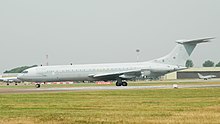
The Avro Blue Steel was a British air-launched, rocket-propelled nuclear armed standoff missile, built to arm the V bomber force. It allowed the bomber to launch the missile against its target while still outside the range of surface-to-air missiles (SAMs). The missile proceeded to the target at speeds up to Mach 3, and would trigger within 100 m of the pre-defined target point.

The "V bombers" were the Royal Air Force (RAF) aircraft during the 1950s and 1960s that comprised the United Kingdom's strategic nuclear strike force known officially as the V force or Bomber Command Main Force. The three models of strategic bomber, known collectively as the V class, were the Vickers Valiant, which first flew in 1951 and entered service in 1955; the Avro Vulcan, which first flew in 1952 and entered service in 1956; and the Handley Page Victor, which first flew in 1952 and entered service in 1957. The V Bomber force reached its peak in June 1964 with 50 Valiants, 70 Vulcans and 39 Victors in service.

The Avro Vulcan is a jet-powered, tailless, delta-wing, high-altitude, strategic bomber, which was operated by the Royal Air Force (RAF) from 1956 until 1984. Aircraft manufacturer A.V. Roe and Company (Avro) designed the Vulcan in response to Specification B.35/46. Of the three V bombers produced, the Vulcan was considered the most technically advanced, hence the riskiest option. Several reduced-scale aircraft, designated Avro 707s, were produced to test and refine the delta-wing design principles.

The Vickers Valiant was a British high-altitude jet bomber designed to carry nuclear weapons, and in the 1950s and 1960s was part of the Royal Air Force's "V bomber" strategic deterrent force. It was developed by Vickers-Armstrongs in response to Specification B.35/46 issued by the Air Ministry for a nuclear-armed jet-powered bomber. The Valiant was the first of the V bombers to become operational, and was followed by the Handley Page Victor and the Avro Vulcan. The Valiant is the only V bomber to have dropped live nuclear weapons.
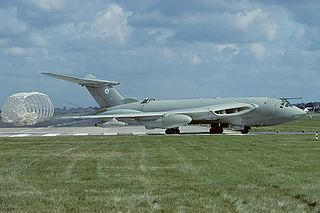
The Handley Page Victor is a British jet-powered strategic bomber developed and produced by Handley Page during the Cold War. It was the third and final V bomber to be operated by the Royal Air Force (RAF), the other two being the Vickers Valiant and the Avro Vulcan. Entering service in 1958, the Victor was initially developed as part of the United Kingdom's airborne nuclear deterrent, but it was retired from the nuclear mission in 1968, following the discovery of fatigue cracks which had been exacerbated by the RAF's adoption of a low-altitude flight profile to avoid interception, and due to the pending introduction of the Royal Navy's submarine-launched Polaris missiles in 1969.

Royal Air Force Waddington otherwise known as RAF Waddington is a Royal Air Force station located beside the village of Waddington, 4.2 miles (6.8 km) south of Lincoln, Lincolnshire, in England.

The Avro Type 694 Lincoln is a British four-engined heavy bomber, which first flew on 9 June 1944. Developed from the Avro Lancaster, the first Lincoln variants were initially known as the Lancaster IV and V; these were renamed Lincoln I and II. It was the 2nd last piston-engined bomber operated by the Royal Air Force (RAF).

Number 617 Squadron is a Royal Air Force aircraft squadron, originally based at RAF Scampton in Lincolnshire and currently based at RAF Marham in Norfolk. It is commonly known as "The Dambusters", for its actions during Operation Chastise against German dams during the Second World War. In the early 21st century it operated the Panavia Tornado GR4 in the ground attack and reconnaissance role until being disbanded on 28 March 2014. The Dambusters reformed on 18 April 2018, and was equipped at RAF Marham in June 2018 with the Lockheed Martin F-35B Lightning, becoming the first squadron to be based in the UK with this advanced STOVL type. The unit is composed of both RAF and Royal Navy personnel, and operates from the Royal Navy's Queen Elizabeth-class aircraft carriers.
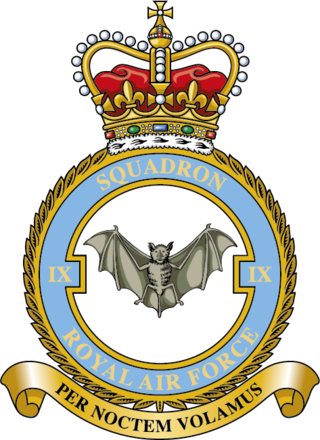
Number 9 Squadron is the oldest dedicated Bomber Squadron of the Royal Air Force. Formed in December 1914, it saw service throughout the First World War, including at the Somme and Passchendaele. During the Second World War, No. IX (B) Squadron was one of two Avro Lancaster units specialising in heavy precision bombing and sank the battleship Tirpitz on 12 November 1944 in Operation Catechism. Between 1962 and April 1982, the squadron flew the Avro Vulcan B.2 as part of the V-Force. In June 1982, it became the first front-line squadron in the world to operate the Panavia Tornado GR.1. In May 1998, No. IX (B) Squadron received the RAF's first Tornado GR.4, which it operated until reequipping with the Eurofighter Typhoon FGR.4 at its present home base of RAF Lossiemouth on 1 April 2019.

No. 27 Squadron of the Royal Air Force operates the Boeing Chinook from RAF Odiham.

Number 12 Squadron, also known as No. 12 (Bomber) Squadron and occasionally as No. XII Squadron, is a flying squadron of the Royal Air Force (RAF). The squadron reformed in July 2018 as a joint RAF/Qatar Emiri Air Force squadron. It is currently based at RAF Coningsby, Lincolnshire, and operates the Eurofighter Typhoon FGR4, while temporarily integrating Qatari air and ground crews in order to provide training and support as part of the Qatari purchase of 24 Typhoons from the UK.

Number 15 Squadron, sometimes written as No. XV Squadron, was a squadron of the Royal Air Force. It most recently operated the Panavia Tornado GR4 from RAF Lossiemouth as No. XV (Reserve) Squadron. It was the RAF's Operational Conversion Unit for the Tornado GR4 which taught pilots and Weapon Systems Officers (WSO) how to fly the aircraft and what tactics to use to best exploit the performance of their aircraft and its weapons.

No. 35 Squadron was a squadron of the Royal Air Force.

No. 40 Squadron of the Royal Air Force was formed in 1916 at Gosport as No. 40 Squadron Royal Flying Corps and was disbanded for the last time in 1957. The squadron also included many non-British members, including volunteers from the Royal Australian Air Force and Royal Canadian Air Force.
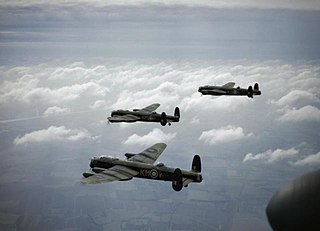
Number 44 (Rhodesia) Squadron was an aviation unit of the Royal Air Force. It was active between 1917 and 1982. For most of its history it served as a heavy bomber squadron.

Number 57 Squadron, also known as No. LVII Squadron, is a Royal Air Force flying training squadron, operating the Grob Prefect T1 from RAF Cranwell, Lincolnshire.
No. 58 Squadron was a squadron of the Royal Air Force. For much of its service history in the First and Second World Wars, it operated as a bomber squadron. In the later stages of the Second World War, it was part of Coastal Command and was engaged in anti-submarine patrols.
No. 83 Squadron RAF was a Royal Flying Corps and Royal Air Force squadron active from 1917 until 1969. It was operative during both the First World War and the Second World War.

Project E was a joint project between the United States and the United Kingdom during the Cold War to provide nuclear weapons to the Royal Air Force (RAF) until sufficient British nuclear weapons became available. It was subsequently expanded to provide similar arrangements for the British Army of the Rhine. A maritime version of Project E known as Project N provided nuclear depth bombs used by the RAF Coastal Command.
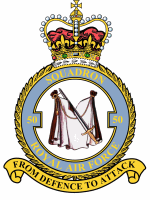
No. 50 Squadron was a squadron of the Royal Air Force. It was formed during the First World War as a home defence fighter squadron, and operated as a bomber squadron during the Second World War and the Cold War. It disbanded for the last time in 1984.



